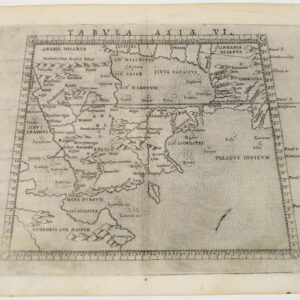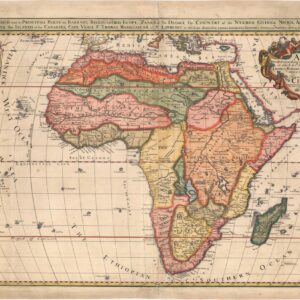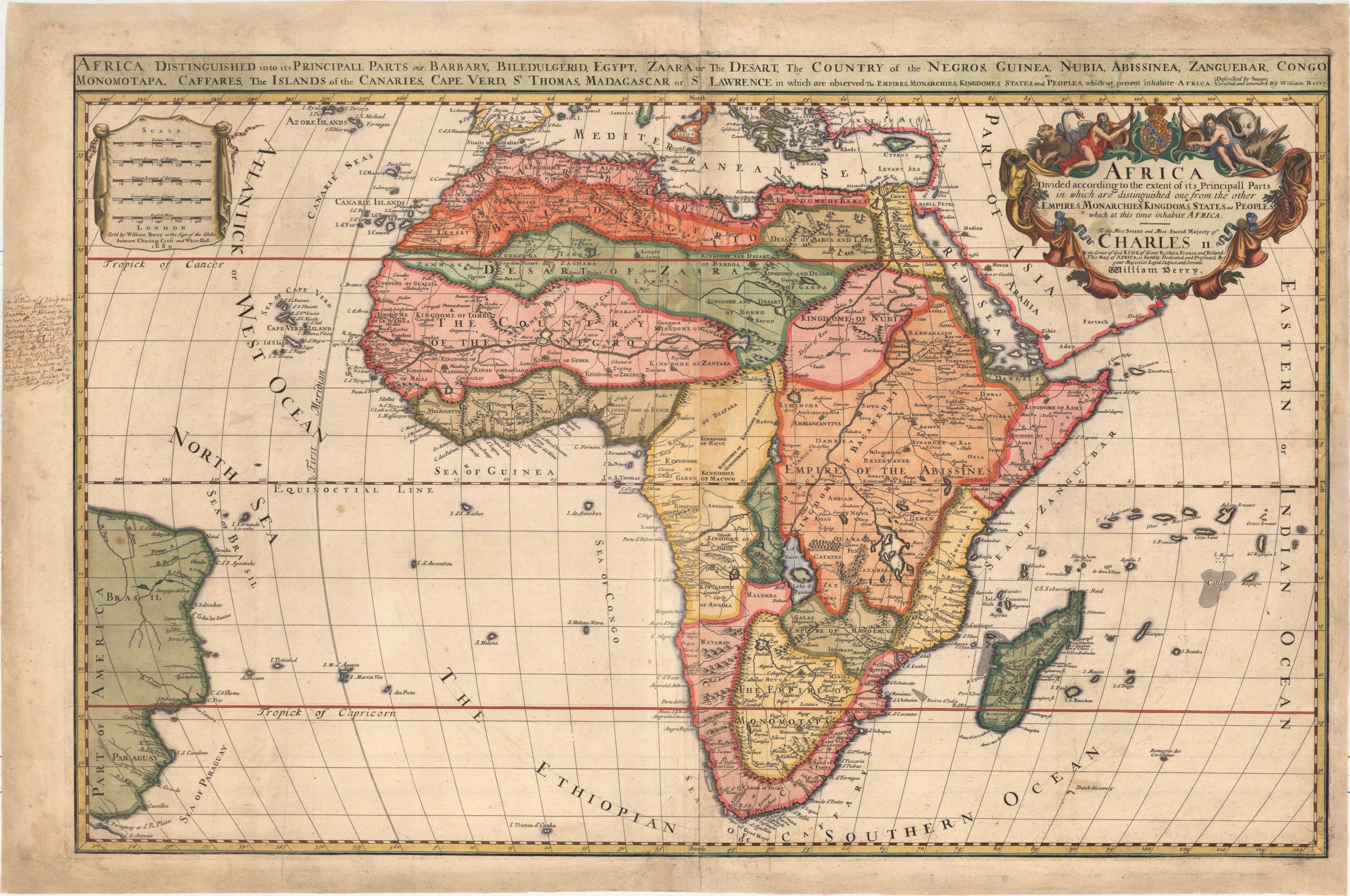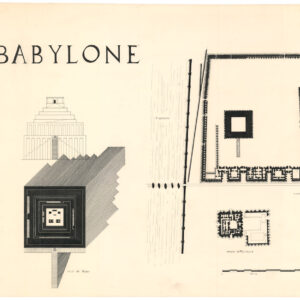An annotated map of the Sinai from the height of the British Empire.
[With Extensive Contemporary Annotations] Ordnance Survey of the Peninsula of Sinai Made in 1868-9.
$3,500
1 in stock
Description
During the 19th century, an intellectual battle raged in Christendom: how could the traditional tenements of faith be aligned with the rapid and dramatic expansion of knowledge that scientific thought and method had brought about? This fundamental question plagued many great minds in Victorian Britain, and a wide range of new initiatives were launched throughout the Empire as a direct consequence. Many projects were conceived with the intention of bridging the gap between faith and reason, but few more explicitly so than the cartographic surveys conducted jointly by the War Office and the Palestine Exploration Fund (PEF) in the 1860s and 1870s. Naturally, such collaboration hinged on a strategic interest in establishing reliable maps of the region, and the work was done with great precision, using the latest surveying tools and techniques. The underlying ambition, however, was to begin mapping a Biblical landscape.
This British Army survey map was produced as part of the PEF’s Ordnance Survey of the Sinai Peninsula in 1868-69. This particular sheet covers the southwestern quadrant of the peninsula, depicting the western coastline (Gulf of Suez) from Jabal Faraun and Wadi Useit in the north, to Ras Tor (or Tur) in the south. More importantly, however, it includes important historical locations such as Mt Sinai and the Monastery of St Catherine.
This particular map is extensively annotated in English using black ink and different pencils. These include the underlining of Arabic toponyms in blue and red pencil to emphasize particular places on known routes, as well extensive notes on the character and nature of different routes written in pencil (seemingly as the result of direct personal observation). In the SE corner of the map is a detailed legend in pencil referring to Biblical occurrences and linking them to specific places on the map. The annotations become denser around Jebel Musa (Mountain of Musa) and Jebel Katharina. The latter is the modern Mt. Sinai, where the famous Greek-Orthodox monastery of the same name is located. The original monastery was built in the 6th century CE by Byzantine emperor Justinian as a replacement for the 3rd century Monastery of the Burning Bush, commissioned by Constantine the Great’s Christian mother, Helena. Today, a congregation of devout Greek-Orthodox monks continues to run the monastery, which among other things is famed for its extensive library of ancient Judeo-Christian texts and codices.
On the map’s verso, the name de Faye 1884 is written in black ink. This refers to the map’s original owner, Pastor Clément de Faye (1824-1902), a French ecclesiastical scholar and translator, who is likely to have traveled in the region during the 1880s. It is unclear whether the annotations on the map belong to de Faye exclusively, but the Biblical referencing suggests that a substantial portion of the annotations were indeed made by him.
Background
The Ordnance Survey was, and still is, the official National Mapping Agency in Great Britain. Founded in 1791 as the cartographic arm of the British Army, The Ordnance Survey was primarily responsible for mapping Great Britain itself. Yet as the British Empire expanded its holdings militarily, Ordnance Surveys were instigated at key locations throughout the world, often in collaboration with other governmental or semi-governmental bodies. In the Sinai Peninsula, the partner was the PEF, whose express purpose was to chart ‘The Holy Land’ in both geographical and historical terms. Consequently, establishing a detailed overview of the region was key; both in regard to the religiously motivated exploration, but also in regard to cementing supremacy of crucial infrastructure (in this case the Suez Canal).
The formal goal of the survey was to ‘resolve contemporary controversies in Biblical and philological scholarship (…) and to determine the path of the Exodus, to identify Mount Sinai and to investigate the rock inscriptions in Wadi Mukatteb’. It was, in other words, about establishing the actual physical locations for Biblical events such as Exodus and Moses’ reception of the Ten Commandments. This ambition is clearly reflected in the map on several levels. Most obvious is perhaps the contrast between the areas deemed of historical interest and those that were not. Thus we see certain areas documented with great meticulousness, while large swathes of land remained completely uncharted.
An example of this can be seen in the stark contrast between an almost naked coastline and the organic valleys shaped by seasonal riverbeds (wadi in Arabic) in the interior. But the wadi systems of the Sinai were not just dried-out riverbeds. They also functioned as protective corridors of movement through an otherwise inhospitable and arid landscape. It is precisely because of this characteristic that these systems became a focal point for the surveyors. Surely, the escaping Israelites must have followed these physical transects as well. Consequently, any epigraphy and archaeology was carefully documented and usually included on the maps (often labeled ‘stone circle’ or ‘inscription’). The hope was that further study of these findings eventually would help confirm locations as actual sites from the Bible.
Cartographer(s):
Charles William Wilson (1836-1905) was a British Army officer, archaeologist and geographer. Following several years in the American West, Wilson was transferred to Palestine in 1864 where he became deeply engaged in the formation of the Palestine Exploration Fund (PEF) and spearheaded the Ordnance Survey of Jerusalem, which became a tremendous success. He also conducted excavations on the Temple Mount. In 1868, Wilson joined the Ordnance Survey of the Sinai, helping to produce a series of spectacular and detailed maps of the region. He served as Chairman for the PEF from 1901 until his death.
Captain H.S. PalmerHenry Spencer Palmer (1834-1893) was a British Army engineer and surveyor born to an English officer’s family in Bangalore, India. He studied at private schools in England and was commissioned as an engineer lieutenant in 1856 after only a year of study. In 1858, he was assigned to a military survey mission in British Columbia, from which he wrote several contributions to the Royal Geographic Society. From the mid 1860s, Palmer worked as a cartographer on a number of Ordnance Surveys, including those in Palestine, Great Britain and New Zealand. Upon retiring in 1887, he settled in Tokyo.
Condition Description
Dissected and laid on contemporary linen, with original slip case.
References
Higuchi, Jiro (2002). Henry Spencer Palmer, 1838-93. In Britain & Japan: Biographical Portraits, edited by Hugh Cortazzi. Japan Library, Tokyo (ISBN 1-903350-14-X).
Schwartz, Joan & James Ryan eds. (2003) Picturing Place: Photography and the Geographical Imagination. Bloomsbury, London (ISBN 10: 1860647529).
Wilson, Charles W. (1865). Ordnance Survey of Jerusalem. Published by Authority of the Lords Commissioners of Her Majesty’s Treasury, London.
See also Palestine Exploration Fund (https://www.pef.org.uk)

![[South Africa] Photograph panorama of Cape Town, c. 1870](https://neatlinemaps.com/wp-content/uploads/2022/09/Screen-Shot-2022-12-18-at-11.22.15-AM-300x300.png)


